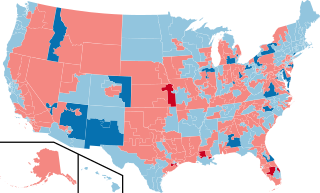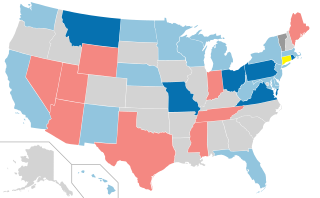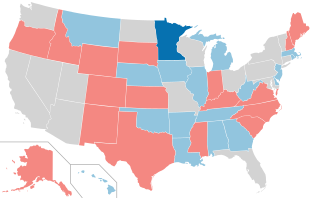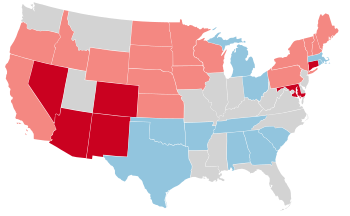
The 82nd United States Congress was a meeting of the legislative branch of the United States federal government, composed of the United States Senate and the United States House of Representatives. It met in Washington, D.C. from January 3, 1951, to January 3, 1953, during the last two years of the second administration of U.S. President Harry S. Truman.

Scott Wike Lucas was an American attorney and politician. A member of the Democratic Party, he represented Illinois in the U.S. House of Representatives (1935–1939) and the U.S. Senate (1939–1951). He was the Senate Majority Leader from 1949 to 1951.

The 1950 United States Senate elections occurred in the middle of Harry S. Truman's second term as President. As with most 20th-century second-term mid-terms, the party not holding the Presidency made significant gains. The Republican opposition made a net gain of five seats, taking advantage of the Democratic administration's declining popularity during the Cold War and the aftermath of the Recession of 1949. The Democrats held a narrow 49-to-47-seat majority after the election. This was the first time since 1932 that the Senate Majority Leader lost his seat, and the only instance of the majority leader losing his seat while his party retained the majority.

The 1948 United States Senate elections were elections which coincided with the election of Democratic President Harry S. Truman for a full term. Truman had campaigned against an "obstructionist" Congress that had blocked many of his initiatives, and in addition the U.S. economy recovered from the postwar recession of 1946–47 by election day. Thus Truman was rewarded with a Democratic gain of nine seats in the Senate, enough to give them control of the chamber. This was the last time until 2020 that Democrats flipped a chamber of Congress in a Presidential election cycle.

The 1946 United States Senate elections were held November 5, 1946, in the middle of Democratic President Harry S. Truman's first term after Roosevelt’s passing. The Republicans took control of the Senate by picking up twelve seats, mostly from the Democrats.

The 1934 United States Senate elections were held in the middle of Democratic President Franklin D. Roosevelt's first term. During the Great Depression, voters strongly backed Roosevelt's New Deal and his allies in the Senate, with Democrats picking up a net of nine seats, giving them a supermajority. This marked the second time since the Civil War when an incumbent president's party gained Senate seats during a midterm election since 1914, half-way through Woodrow Wilson's first term. Neither party registered a net gain of Senate seats in a mid-term election again until the Democrats gained a net of four seats in 1962, at the mid-point of John F. Kennedy's term. In 1970, the Republicans gained a net of one seat during the term of Richard Nixon. In 2002, George W. Bush's party gained a net of two seats, and Donald Trump in 2018 had the Republican Party gain 2 seats in the senate.

The 1952 United States House of Representatives elections was an election for the United States House of Representatives in 1952 which coincided with the election of President Dwight Eisenhower. Eisenhower's Republican Party gained 22 seats from the Democratic Party, gaining a majority of the House. However, the Democrats had almost 250,000 more votes (0.4%) thanks to overwhelming margins in the Solid South. This would be the last time the Republican Party won a majority in the House until 1994. It was also the last election when both major parties increased their share of the popular vote simultaneously, largely due to the disintegration of the American Labor Party and other third parties. As of 2022, this is the last time the House changed partisan control during a presidential cycle.

The 1950 United States House of Representatives elections was an election for the United States House of Representatives in 1950 which occurred in the middle of President Harry Truman's second term.

The 2008 United States House of Representatives elections were held on November 4, 2008, to elect members to the United States House of Representatives to serve in the 111th United States Congress from January 3, 2009, until January 3, 2011. It coincided with the election of Barack Obama as President. All 435 voting seats, as well as all 6 non-voting seats, were up for election. The Democratic Party, which won a majority of seats in the 2006 election, expanded its control in 2008.

The 2006 United States elections were held on Tuesday, November 7, 2006, in the middle of Republican President George W. Bush's second term. Democrats won control of both houses of Congress, which was the first and only time either party did so since the 1994 elections. These elections were widely categorized as a Democratic wave.

The 2008 United States elections were held on November 4. Democratic Senator Barack Obama of Illinois won the presidential election, by defeating his near rival John McCain and the Democrats bolstered their majority in both Houses of Congress.

The 1948 United States elections were held on November 2, 1948. The election took place during the beginning stages of the Cold War. Democratic incumbent President Harry S. Truman was elected to a full term, defeating Republican nominee New York Governor Thomas E. Dewey and two erstwhile Democrats. The Republicans, who had just won both the House and the Senate two years earlier, ceded control of both chambers of Congress to the Democrats. Puerto Rico also elected Luis Muñoz Marín of the Popular Democratic Party as its first democratically elected governor.

The 1996 United States elections were held on November 5. Democratic President Bill Clinton won re-election, while the Republicans maintained their majorities in both houses of the United States Congress.

The history of the United States Congress refers to the chronological record of the United States Congress including legislative sessions from 1789 to the present day. It also includes a brief history of the Continental Congress from 1774 through 1781 and the Congress of the Confederation from 1781 to 1789.

The 1988 United States elections were held on November 8 and elected the members of the 101st United States Congress. The Republican Party retained the presidency, while the Democratic Party retained control of Congress.

The 1990 United States elections were held on November 6 and elected the members of the 102nd United States Congress. The elections occurred in the middle of Republican President George H. W. Bush's term.

The 1966 United States elections were held on November 8, 1966, and elected the members of the 90th United States Congress. The election was held in the middle of Democratic President Lyndon B. Johnson's second term, and during the Vietnam War. Johnson's Democrats lost forty-seven seats to the Republican Party in the House of Representatives. The Democrats also lost three seats in the U.S. Senate to the Republicans. Despite their losses, the Democrats retained control of both chambers of Congress. Republicans won a large victory in the gubernatorial elections, with a net gain of seven seats. This was the first election held after the passage of the Voting Rights Act of 1965, which led to a surge in African-American voter participation.

The 1952 United States elections were held on November 4, 1952. The Republicans took control of the presidency and both chambers of Congress for the first time since the Great Depression. The election took place during the Korean War.

The 1946 United States elections were held on November 5, 1946, and elected the members of the 80th United States Congress. In the first election after World War II, incumbent President Harry S. Truman and the Democratic Party suffered large losses. After having been in the minority of both chambers of Congress since 1932, Republicans took control of both the House and the Senate.

The 1894 United States elections was held on November 6, and elected the members of the 54th United States Congress. These were mid-term elections during Democratic President Grover Cleveland's second term. The Republican landslide of 1894 marked a realigning election In American politics as the nation moved from the Third Party System that had focused on issues of civil war and reconstruction, and entered the Fourth Party System, known as the Progressive Era, which focused on middle class reforms.




















